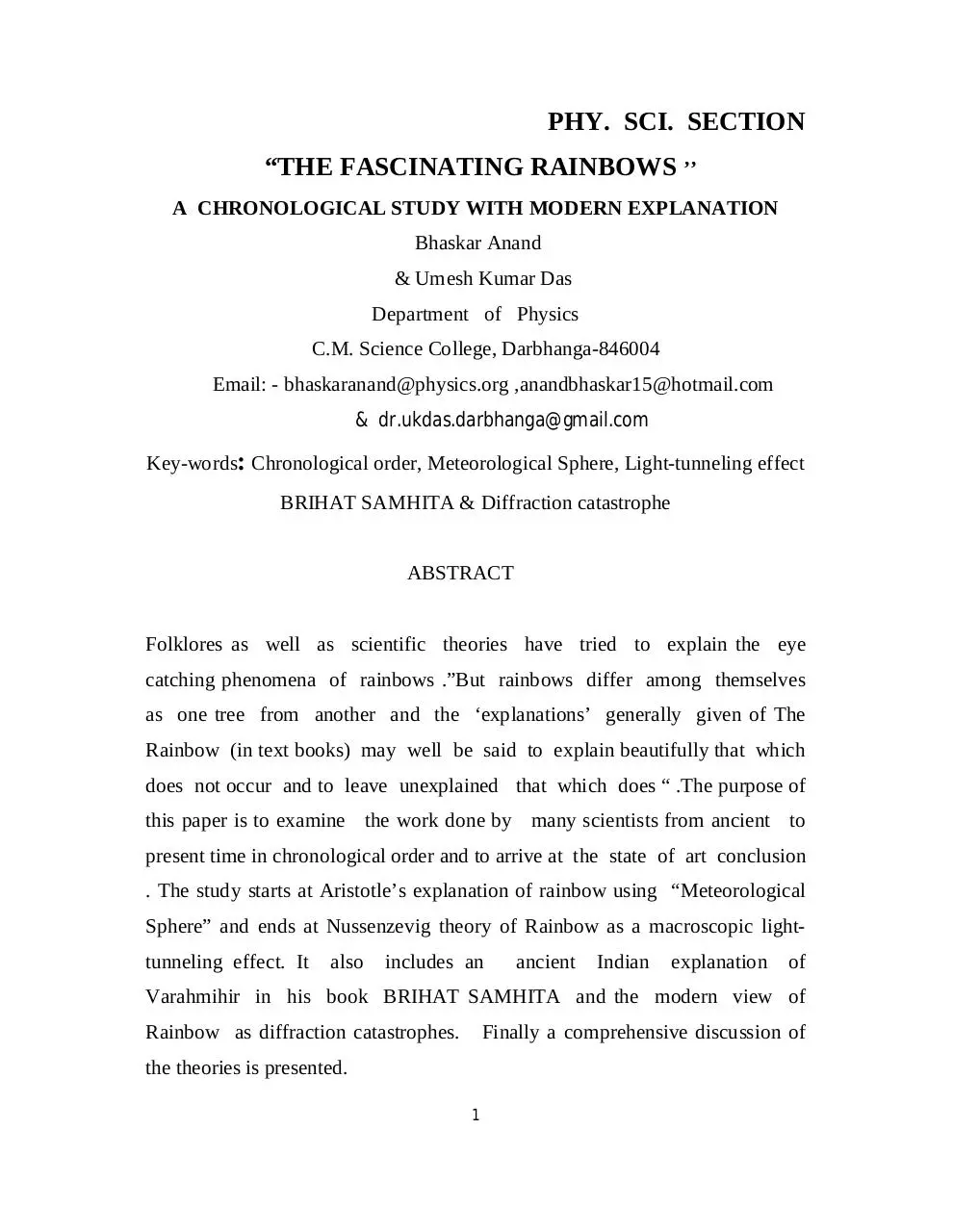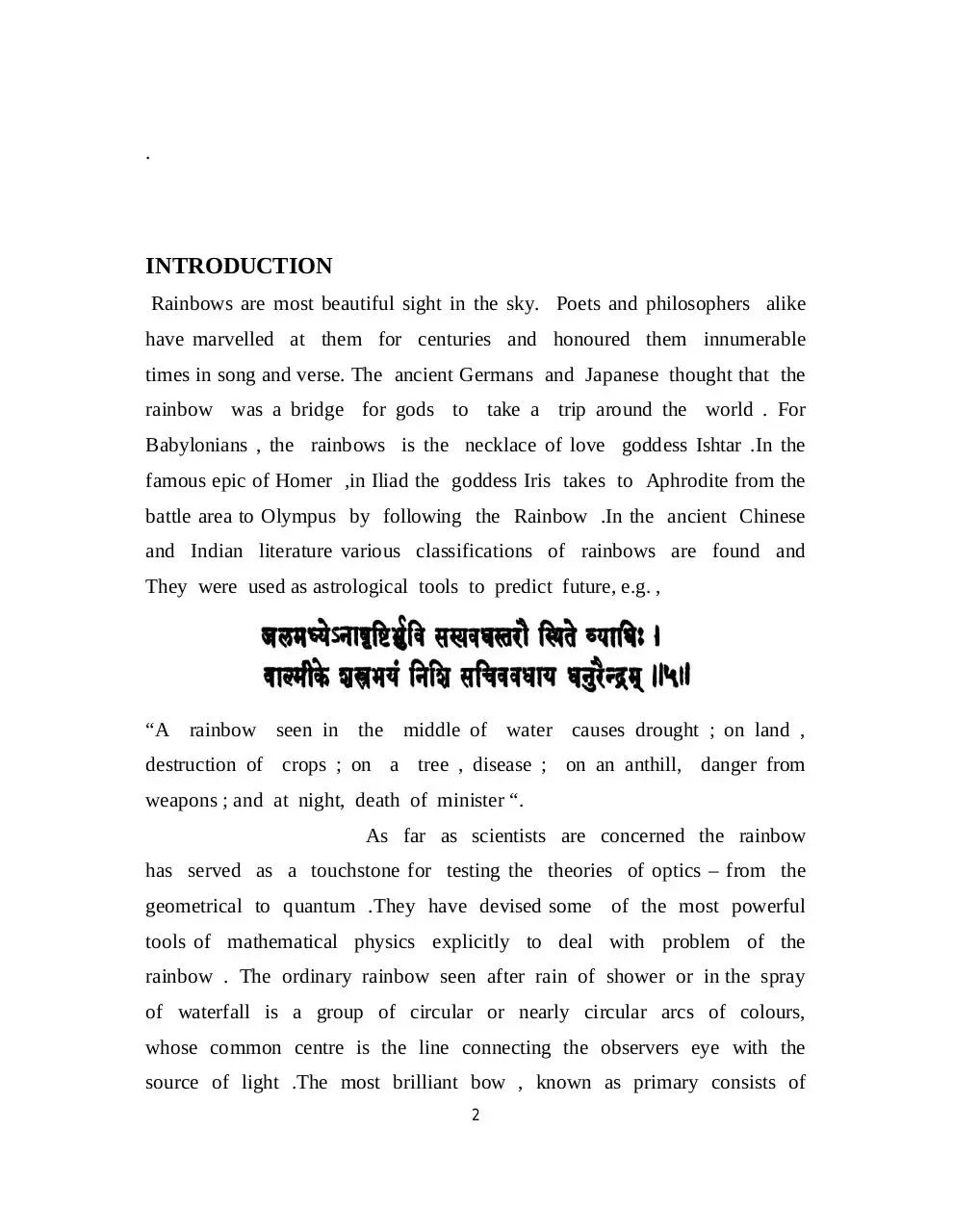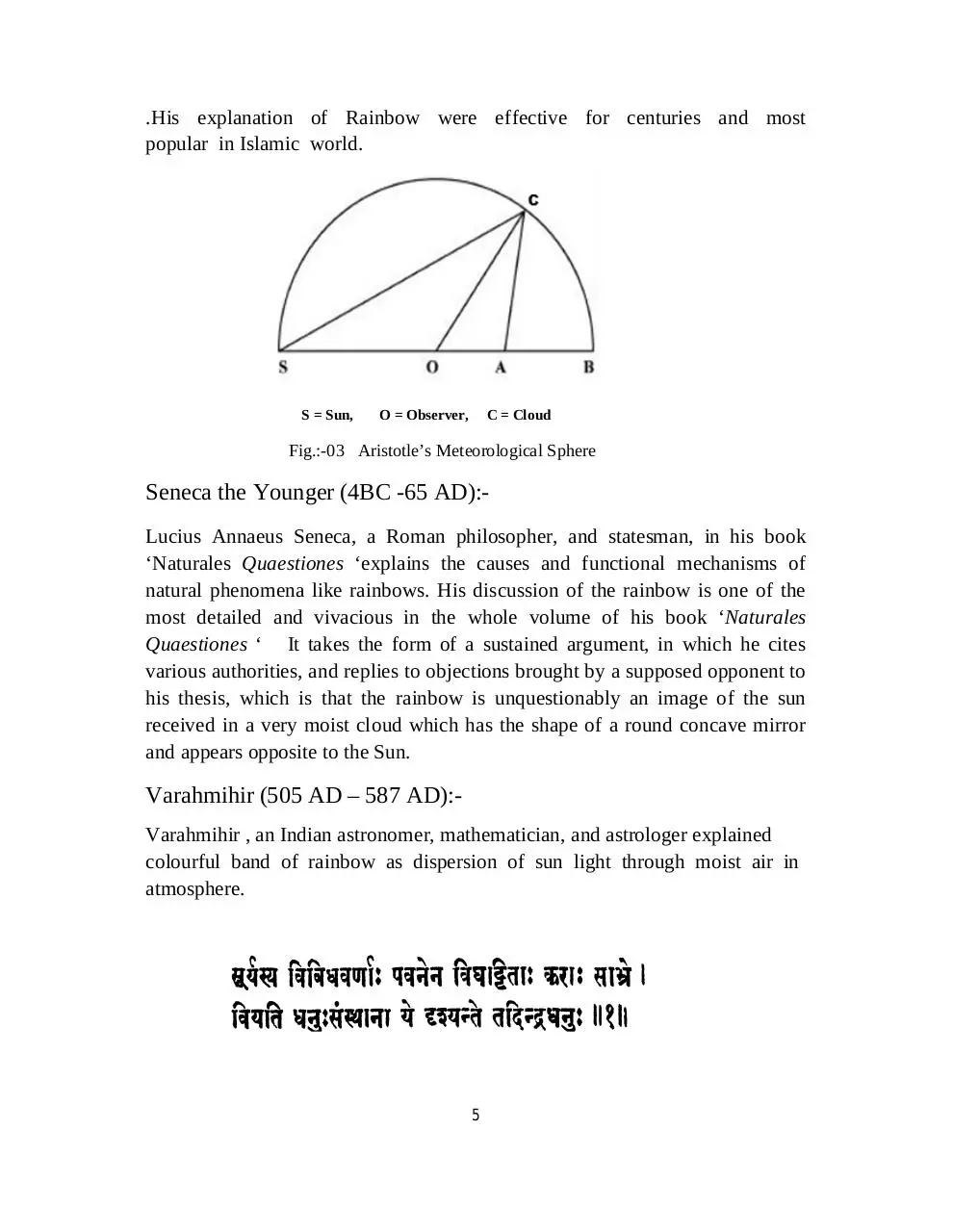THE FASCINATING RAINBOWS BY BHASKAR ANAND (PDF)
File information
This PDF 1.5 document has been generated by / doPDF Ver 7.3 Build 382 (Windows 7 Ultimate Edition - Version: 6.1.7600 (x86)), and has been sent on pdf-archive.com on 12/11/2015 at 02:50, from IP address 223.176.x.x.
The current document download page has been viewed 1090 times.
File size: 1.88 MB (16 pages).
Privacy: public file





File preview
PHY. SCI. SECTION
“THE FASCINATING RAINBOWS ’’
A CHRONOLOGICAL STUDY WITH MODERN EXPLANATION
Bhaskar Anand
& Umesh Kumar Das
Department of Physics
C.M. Science College, Darbhanga-846004
Email: - bhaskaranand@physics.org ,anandbhaskar15@hotmail.com
& dr.ukdas.darbhanga@gmail.com
Key-words: Chronological order, Meteorological Sphere, Light-tunneling effect
BRIHAT SAMHITA & Diffraction catastrophe
ABSTRACT
Folklores as well as scientific theories have tried to explain the eye
catching phenomena of rainbows .”But rainbows differ among themselves
as one tree from another and the ‘explanations’ generally given of The
Rainbow (in text books) may well be said to explain beautifully that which
does not occur and to leave unexplained that which does “ .The purpose of
this paper is to examine the work done by many scientists from ancient to
present time in chronological order and to arrive at the state of art conclusion
. The study starts at Aristotle’s explanation of rainbow using “Meteorological
Sphere” and ends at Nussenzevig theory of Rainbow as a macroscopic lighttunneling effect. It
also
includes an
ancient
Indian
explanation
of
Varahmihir in his book BRIHAT SAMHITA and the modern view of
Rainbow as diffraction catastrophes.
Finally a comprehensive discussion of
the theories is presented.
1
.
INTRODUCTION
Rainbows are most beautiful sight in the sky. Poets and philosophers alike
have marvelled at them for centuries and honoured them innumerable
times in song and verse. The ancient Germans and Japanese thought that the
rainbow was a bridge for gods to take a trip around the world . For
Babylonians , the rainbows is the necklace of love goddess Ishtar .In the
famous epic of Homer ,in Iliad the goddess Iris takes to Aphrodite from the
battle area to Olympus by following the Rainbow .In the ancient Chinese
and Indian literature various classifications of rainbows are found and
They were used as astrological tools to predict future, e.g. ,
“A rainbow seen in the middle of water causes drought ; on land ,
destruction of crops ; on a tree , disease ; on an anthill, danger from
weapons ; and at night, death of minister “.
As far as scientists are concerned the rainbow
has served as a touchstone for testing the theories of optics – from the
geometrical to quantum .They have devised some of the most powerful
tools of mathematical physics explicitly to deal with problem of the
rainbow . The ordinary rainbow seen after rain of shower or in the spray
of waterfall is a group of circular or nearly circular arcs of colours,
whose common centre is the line connecting the observers eye with the
source of light .The most brilliant bow , known as primary consists of
2
fixed sequence of colours ; Violet is innermost bending gradually with
various shades of Blue, Green , yellow and Orange with Red outermost .
Fig.:-01 (A) Primary Rainbow
(B) Primary & Secondary Rainbow with Alexander’s dark band
Higher in the sky than the primary bow is the secondary bow in which
colours appear in
in reverse
order , with Red innermost and
violet
outermost .The region between the two bows is considerably darker than
the surrounding sky and has been given the name Alexander’s dark band
, after the Greek philosopher Alexander
of Aphrodisias who first
described it in about 200 AD .
Another feature that is sometimes seen
is the presence of supernumerary arcs . These are series of faint narrow
bands usually pink and green alternately on the inner side of the primary
bow and at times on the outer side of secondary bow. The records of
close observations of rainbow show that not even the colours are always
the same; neither is the band of any colour of constant angular width ;
nor the total breadth of the several colours at all uniform ; similarly the
purity and brightness of different colours are subject to large variations .
3
The greatest contrast is between the sharply defined brilliant rainbow of
retreating thunderstorms and that ill defined faintly tinged bow that
sometimes appear in the mist - the “ White bow or Fog bow” .
Also there have been at least two recorded observations in the past of
vibrations in the rainbow caused by thunder.
There
have
been
no
verified observations of any but the first two rainbows in a natural
landscape . Yet in 1868, Billet was able to detect first 19 rainbows from
a thin stream of water which was illuminated with various coloured
lamps . In a recent report , an apparatus has been described that can
visualize the creation of rainbows using a cylinder of acrylite glass . The
apparatus
allows one to observe rainbow up to the sixth order. It is claimed
that with an intense light source and a good camera ,it is possible to use
the apparatus as a classroom demonstration .
In this
paper we present a
brief review of various theories advanced by scientists of different ages in
a chronological order .
Aristotle (385 BC -322 BC):Aristotle, a Greek philosopher and scientist, was perhaps the first one to have
attempted a rational explanation of rainbow. He proposed that the rainbow is
actually an unusual kind of reflection of sunlight from clouds .He
believed in what he called “meteorological sphere” with dense cloud inside
.The Rainbow occurs if after reflection from dense clouds in the
“meteorological sphere”, the rays of sunlight reaches the observers eye
which lies at centre of the hemispherical shape of the bow .
Aristotle thus
can be given the credit to have perceived that the rainbow is not a
material object with a definite location in sky but rather a set of
directions along which light is strongly scattered into the eyes of observer
4
.His explanation of Rainbow were effective for centuries and most
popular in Islamic world.
S = Sun,
O = Observer,
C = Cloud
Fig.:-03 Aristotle’s Meteorological Sphere
Seneca the Younger (4BC -65 AD):Lucius Annaeus Seneca, a Roman philosopher, and statesman, in his book
‘Naturales Quaestiones ‘explains the causes and functional mechanisms of
natural phenomena like rainbows. His discussion of the rainbow is one of the
most detailed and vivacious in the whole volume of his book ‘Naturales
Quaestiones ‘ It takes the form of a sustained argument, in which he cites
various authorities, and replies to objections brought by a supposed opponent to
his thesis, which is that the rainbow is unquestionably an image of the sun
received in a very moist cloud which has the shape of a round concave mirror
and appears opposite to the Sun.
Varahmihir (505 AD – 587 AD):Varahmihir , an Indian astronomer, mathematician, and astrologer explained
colourful band of rainbow as dispersion of sun light through moist air in
atmosphere.
5
In Chapter -35 (INDRAYOUDH LAKSHANADHAYAH) of his book
‘
BRIHAT SAMHITA , He not only explained rainbow and its types as
primary & secondary but exemplified the divination in best way . He
draws up meticulous list of signs which indicate the arrival of rain ,
flood, draught, Storms and earthquake and many other forecasts based on
rainbow.
Ibn al-Haytham (965 – 1039):Abū Alī al-Ḥasan ibn al-Ḥasan ibn al-Haytham, an Arab Muslim, polymath and
philosopher has been accepted as the greatest scholar of optics of all times and
was also called as the second Ptolemy .He carried out successfully refraction
experiments and extensive studies on the subject. Ibn al-Haytham treated the
formation of rainbow in an article “Maqala Fi Al-Hala Wa Qaws Quzah”. In
this article he explained the formation of rainbow as an image at a concave
mirror. If the rays of light coming from a farther light source reflected to any
point on axis of the concave mirror, they form concentric circles about that
point. He, therefore, concluded that the rainbow is formed as a result of the
reflection from the cloud. Although it is a different approach, it does not
contribute much to the problem. Whether the cloud is plain or concave, it is not
significant for the correct understanding, since the approach is merely based on
reflection. He made no significant contribution to the problem of the formation
of the rainbow. However, his optical studies in general and particularly his
success in geometrical optics had a great influence on his successors.
Ibn Sina (980-1037):Abu Ali al-Ḥusayn ibn ʿAbd Allah ibn Sina (Avicenna) , a Persian polymath,
is regarded as one of the most significant thinkers and writers of the Islamic
Golden Age. His study of rainbow is not much different from Aristotle’s study.
According to Ibn Sina, rainbow is formed as a result of the reflection of light
from the small transparent dewdrop particles dispersed in wet air rather than in
the cloud. We can say that Ibn Sina’s only success was that he gave relatively
less importance to the role of the cloud, which was very important in Aristotle’s
account of the rainbow. The idea of using the dew instead of the cloud provided
6
him the possibility to examine the phenomenon geometrically. Unfortunately,
Ibn Sina did not succeed either. His explanations of the secondary rainbow are
not coherent. For him, the light at higher levels, being much closer to the sun, is
reflected more strongly, so the red colour is formed. Accordingly, the outermost
arc of the secondary rainbow must be red. However, it is violet. This indicates
that Ibn Sina’s explanation on the formation of the secondary rainbow was
wrong. But his general observations on the problem were significant with
respect to the fact that they provide more knowledge about the topic.
Shen Kuo (1031 -1095):Shen Kuo , a Chinese polymath and statesman of the Song dynasty,
in his book “Men Qi Bi Ji “ offered an explanation of rainbow and
atmospheric refraction . He also said that position of rainbow was
opposite to that of sun , hence an evening rainbow always appear in
east. He explained rainbow as phenomenon of atmospheric refraction.
Roger Bacon (1214-1294):Roger Bacon , an English philosopher and Franciscan friar, placed considerable
emphasis on the study of nature through empirical methods. He wrote in his
Book “Opus Majus “about experiments with light shining through crystals and
water droplets show the colours of the rainbow. In addition, Bacon was the first
to calculate the angular size of the rainbow. He stated that the rainbow summit
cannot appear higher than 42° above the horizon.. He explained the primary
rainbow, noting that when sunlight falls on individual drops of moisture, the
rays undergo two refractions and one reflection before transmission into the eye
of the observer. He explained the secondary rainbow through a similar analysis
involving two refractions and two reflections.
Qutb al-Din al-Shirazi(1236-1311):Qutb al-Din al-Shirazi , a Persian astronomer , gave fairly accurate explanation
for the rainbow phenomenon. This was elaborated on by his student, Kamāl alDīn al-Fārisī who gave a more mathematically satisfactory explanation of the
rainbow. He "proposed a model where the ray of light from the sun was
refracted twice by a water droplet, one or more reflections occurring between
the two refractions”. He conducted an experiment with a water-filled glass
sphere and showed the Rainbow phenomena; additional refractions due to the
glass could be ignored in his model.
7
Theodoric of Freiberg (1250- 1310):Theodoric of Freiberg, a German theologian and physicist, wrote a treatise on
the rainbow De iride around 1310. His innovations derived from his own
extensive experimental investigations in which he used prisms, screens, and
spherical flasks filled with water. Theodoric regarded a spherical flask as a
model of a raindrop in a cloud. He observed that different colors appeared as he
would raise the flask higher or lower. By covering certain portions of the flask
at a time, one after another, to see where the light would come out, Theodoric
determined the path that light follows from the Sun through the drop to the
human eye to create a rainbow. Moreover, Theodoric also worked out the path
light follows in creating the secondary rainbow. Theodoric, therefore, concluded
that, as a result of the three or four step process of refraction and reflection, one
drop of water would send only one color of light to the eye of the observer. The
rainbow results from a combination of many drops of water in a cloud at
different positions from a center, where the drops at each distance from the
center send a particular color of the rainbow.
Theodoric's explanation of
the primary and secondary rainbows as a result of these three and four-step
processes of refraction and reflection is still regarded as correct.
Kamal al-Din al-Farisi (1267–1319):Kamal al-Din al-Farisi, a prominent Persian contributor of optics, did not write
separate book on the formation of rainbow. But we can have information about
his studies from his Tanqih al-Manazir, which is a commentary on Ibn alHaytham's Kitab al-Manazir. In this commentary book, Kamal al-Din al-Farisi
dealt with Ibn al-Haytham's work on Burning Spheres. There, Ibn al-Haytham
had postulated some principles for Burning Spheres that Kamal al-Din al-Farisi
tried to interpret.
According to Kamal al-Din al-Farisi, when the sunrays
fall on a reflective or refractive surface, they reflect from or refract to another
point. If there is another reflective or refractive surface, they will continue
reflection or refraction. This may happen several times. But through these
processes the structure of the ray never changes but remains the same. When a
transparent sphere is placed in front of an eye, a cone occurs with the axis of a
straight line between eye and the surface in front of it. Rays coming from the
axis pass through the sphere without changing the direction, that is, they do not
deviate, but the others deviate because of density of the sphere.
8
(A)
(B)
(C)
(D)
Fig.:- 04 (A) The paths of rays in a transparent sphere (B) Double refraction of a ray in a
transparent sphere (C) Double refraction and one reflection of a ray (D) Double refraction
and double reflection of a ray
9
Download THE FASCINATING RAINBOWS BY BHASKAR ANAND
THE FASCINATING RAINBOWS BY BHASKAR ANAND.pdf (PDF, 1.88 MB)
Download PDF
Share this file on social networks
Link to this page
Permanent link
Use the permanent link to the download page to share your document on Facebook, Twitter, LinkedIn, or directly with a contact by e-Mail, Messenger, Whatsapp, Line..
Short link
Use the short link to share your document on Twitter or by text message (SMS)
HTML Code
Copy the following HTML code to share your document on a Website or Blog
QR Code to this page

This file has been shared publicly by a user of PDF Archive.
Document ID: 0000314302.